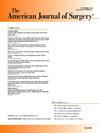不只是卡在中间:峡部乳头状甲状腺癌可能表现为侵袭性特征和淋巴结转移
IF 2.7
3区 医学
Q1 SURGERY
引用次数: 0
摘要
分化型甲状腺癌是最常见的内分泌恶性肿瘤,经过适当的治疗,其5年生存率很高。目前的管理指南指出,甲状腺小叶切除术是术前无高危特征证据的乳头状甲状腺癌(PTC)的充分切除。然而,甲状腺峡部PTC的手术范围仍然存在争议,因为淋巴引流不清楚,回顾性研究表明淋巴转移率较高。本研究的目的是探讨峡部PTC患者的手术治疗和预后。方法回顾性分析两个大容量中心2013 - 2021年间138例峡部PTC患者的最终病理。比较术前肿瘤特征、手术病理和术后结果。结果138例患者接受峡部PTC治疗。最常见的是甲状腺全切除术(TT)(70.0%),其次是肺叶切除术(TL, 17.1%)和峡部切除术(TI, 12.9%)。106例Bethesda V/VI型结节患者中,大多数接受了TT(75.5%),其次是TL(13.2%)和TI(11.3%)。Bethesda III/IV型结节患者最常见的是TI(44.4%)或TL(44.4%),其次是TT(11.1%)。与TL和TI相比,TT患者术前影像学可疑淋巴结(n = 30, n = 1, n = 0, p < 0.001)和/或多发结节的发生率分别为73.5%,70.8%,16.7%,p < 0.001)。在TT患者中,48例为中枢性颈椎病(29例为预防性颈椎病,19例为治疗性颈椎病),20例为治疗性颈椎病和侧侧颈椎病。TT患者肿瘤中位大小较大(1.5 cm; TL 1.1 cm; TI 1.0 cm; p = 0.008)。26.1%的患者发现PTC变异。4例患者行完全甲状腺切除术(TL, n = 2; TI, n = 2, p = 0.41)。在99例淋巴结标本中,62例有转移性淋巴结(TT 58.2%, TL 16.7%, TI 11.1%, p = 0.02)。最后一次随访时,10例患者有持续性/复发性疾病(TT: 8, TI: 2, TL: 0)。一年后,在未接受TT治疗的患者中,有10例患者需要甲状腺激素替代(TL: 56%; TI: 10%; p = 0.018)。结论峡部PTC患者3例中有2例存在高危病理变异和阳性淋巴结。对于小的、低风险的肿瘤,TI可能是一种合适的治疗策略,其再手术率与TL相似,需要甲状腺激素替代的比例更低。本文章由计算机程序翻译,如有差异,请以英文原文为准。
More than just stuck in the middle: papillary thyroid cancer of the isthmus may present with aggressive features and nodal metasasis
Introduction
Differentiated thyroid cancer is the most common endocrine malignancy and has an excellent 5-year survival rate after appropriate management. Current management guidelines state that thyroid lobectomy is adequate resection for papillary thyroid cancer (PTC) without preoperative evidence of high-risk features. However, the extent of surgery for PTC in the thyroid isthmus remains controversial, given the unclear lymphatic drainage and retrospective studies suggesting higher rates of lymphatic metastasis. The aim of this study was to examine the surgical management and outcomes of patients with isthmus PTC.
Methods
A retrospective review was performed at two high-volume centers of 138 patients who underwent thyroidectomy between 2013 and 2021 with isthmus PTC on final pathology. Preoperative tumor characteristics, surgical pathology, and postoperative outcomes were compared.
Results
There were 138 patients treated for isthmus PTC. Total thyroidectomy (TT) was most frequently performed (70.0 %), followed by lobectomy (TL, 17.1 %) and isthmusectomy (TI, 12.9 %). Among the 106 patients with Bethesda V/VI nodules, most underwent TT (75.5 %), followed by TL (13.2 %), and TI (11.3 %). Patients with Bethesda III/IV nodules most frequently had TI (44.4 %) or TL (44.4 %), then followed by TT (11.1 %). Patients who underwent TT more frequently had suspicious lymph nodes on preoperative imaging (n = 30, n = 1, n = 0, p < 0.001) and/or multiple nodules than TL and TI respectively (73.5 %, 70.8 %, 16.7 %, p < 0.001). Of TT patients, 48 had central neck dissections (29 prophylactic and 19 therapeutic) and 20 had both therapeutic CND and lateral neck dissections. TT patients had larger median tumor size (1.5 cm; TL 1.1 cm; TI 1.0 cm; p = 0.008). PTC variants were identified in 26.1 % of patients. Completion thyroidectomy was performed in 4 patients (TL, n = 2; TI, n = 2, p = 0.41). Of 99 patients with lymph nodes sampled, 62 patients had metastatic lymph nodes (TT 58.2 %; TL, 16.7 %; TI: 11.1 %; p = 0.02). At the last follow-up, 10 patients had persistent/recurrent disease (TT: 8, TI: 2, TL: 0). At one year, among patients who did not undergo TT, 10 patients required thyroid hormone replacement (TL: 56 %; TI: 10 %; p = 0.018).
Conclusion
Isthmus PTC may present with high-risk pathologic variants and positive nodes in 2 out of 3 patients. TI may be an appropriate management strategy in small, low-risk tumors, with similar reoperation rates as TL and lower rates of needing thyroid hormone replacement.
求助全文
通过发布文献求助,成功后即可免费获取论文全文。
去求助
来源期刊
CiteScore
5.00
自引率
6.70%
发文量
570
审稿时长
56 days
期刊介绍:
The American Journal of Surgery® is a peer-reviewed journal designed for the general surgeon who performs abdominal, cancer, vascular, head and neck, breast, colorectal, and other forms of surgery. AJS is the official journal of 7 major surgical societies* and publishes their official papers as well as independently submitted clinical studies, editorials, reviews, brief reports, correspondence and book reviews.

 求助内容:
求助内容: 应助结果提醒方式:
应助结果提醒方式:


